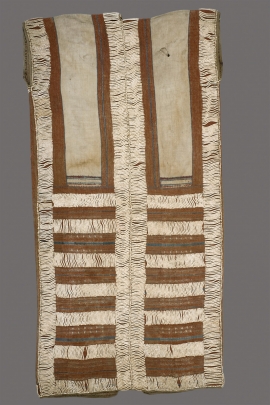TELDAP Collections
| Atayal shell bead shirt |
|
This type of shell bead shirt is referred to as lukkus-kaxa' or lukkus-pintoan in the Atayal language, meaning precious or valuable clothing. The word “lukkus” refers to clothing and “kaxa’”, “axa’” or “aqa’”, depending on the variations in language among the groups of the Atayal tribe, means “bead”. Lukkus-kaxa’ was considered a family heirloom, an ancient form of currency and a commonly used form of compensation. In addition, it was a symbol of honor worn by warriors upon their return from a successful headhunting expedition. The number of shell beads was determined by the number of heads a warrior brought back to the village. If the entire shirt was beaded, this meant that the wearer had obtained the heads of at least five persons. Men who wore the lukkus-kaxa’ were very likely to receive the attention of the single women of the village, as this shirt represented their courage and ability to defend their home and village. Warriors with repeated achievements on the battlefield were given the distinction of wearing a headdress with round shells stitched on, and round shells worn on the chest, in addition to the lukkus-kaxa’. When the practice of headhunting was abolished in Taiwan, the shell bead shirt took on new social meanings. It became an important betrothal gift and was used as currency to purchase farmland and cattle.
Early on, this type of shirt was not found in the Atayal villages of the mountains. According to oral legend, there was a Pingpu (plains Aborigine) tribe living near today’s Puli Town in Nantou County that possessed this type of long shirt. Thus, this type of clothing may have been an “import”, adding to the perception of its value and prestige. Today, all of the known shell bead shirts were passed down among Atayal families. Similar types of shirts have not been found among the Pingpu tribes, thus it is difficult to know with any certainty whether the Pingpu did indeed produce these kinds of shirts. In terms of understanding how these shirts were made, an article on the Atayal shell bead shirt specimens in the collection of the Department of Archaeology and Anthropology (today the Department of Anthropology) of National Taiwan University, written by K.-C. Chang and published in the second issue of the bulletin of that department, provides the following description: Flat, white shells were first broken into smaller pieces. Then a hole was made in the center of each of the pieces. Each bead was ground to form a round bead. The beads were threaded one by one onto a ramie thread to form a strand. When a strand was complete it was sewn onto the shirt. Each strand measures 3 to 5 inches in length. Before it became a lukkus kaxa’ with shell beads it was a plain shirt of white woven ramie called lukkus malat. The ramie was cultivated and then processed into fibers that were woven. Only the chieftain, spiritual leaders (those in charge of upholding the gaga or rules and lessons handed down from the ancestors), skilled hunters and warriors and the most affluent men of the village were allowed to possess such a shirt. Among women only those especially adept at making these kinds of shirts could possess this type of clothing. The shell bead shirt was mostly worn at celebrations following a successful headhunting expedition or at major ceremonies. Wearers of this shirt were certain to be noticed. Alternatively, cloth or clothing with shell beads stitched on was placed on both sides of the pathway leading to the home of a person wanting to atone for a wrongdoing. If the victim of the wrongdoing accepted this compensation, he took the cloth or clothing. If not, he continued along the path to the home to discuss compensation. Sometimes a daughter was required as compensation to resolve a serious dispute. This lukkus-kaxa’ was formed from two pieces of woven ramie cloth. Each piece was folded to form part of the front and back, with no tailoring. There is no color and there are no sleeves or buttons. Approximately 90,000 shell beads have been sewn onto this shirt. The warp includes red, white and blue fibers and the weft red, white and blue fibers. The material is woven ramie. In addition to the horizontal and vertical strands of shell beads, patterns include solid and dotted lines.
Department of Graphic Communications and Digital Publishing, Shih Hsin University Digital archiving project of the Shung Ye Museum of Formosan Aborigines
|














